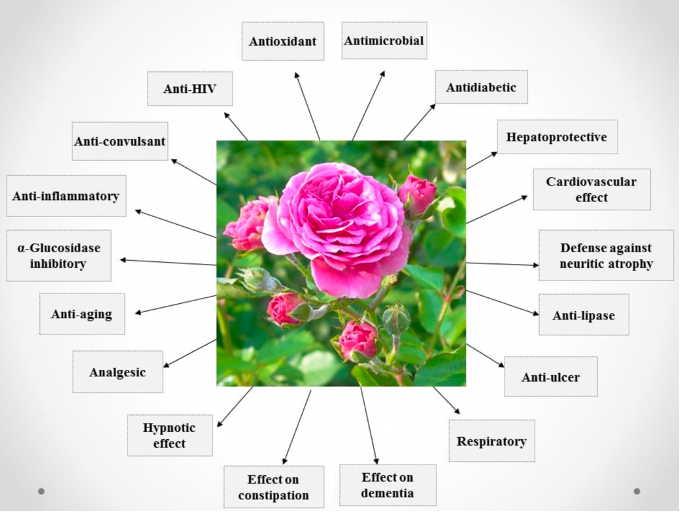Your basket is currently empty!
Chemical constituents, experimental and clinical pharmacology of Rosa damascena
Rosa damascena Mill., commonly known as the Damask rose, is the king of flowers, an ornamental and precious herb with modern pharmacological importance that is used in medicines.
Essential oils are mainly produced in Bulgaria and Turkey, and the best one is Bulgarian Rosa damascena oil. The essential oil of Rosa damascena contains the main components geraniol and citronellol, both of which are pharmacologically active. In addition to its perfumery effects, Rosa damascena has a wide spectrum of biopharmacological activity (as shown in the figure below), including antidepressant, hypoglycemic, anti-inflammatory, analgesic, antioxidant, and antimicrobial properties.

After reviewing the pharmacological investigations of the Rosa damascena, the researchers found that the main product of Rosa damascena is rose water and its oil. Several constituents are present in Rosa damascena, including flavonoids, anthocyanins, terpenes, and glycosides, which have beneficial effects on the body. Investigations confirmed that the Rosa damascena is used for many digestive problems like constipation and as laxative. Eye drop of Rosa damascena is very useful in ophthalmic diseases. The pharmacological activity mentioned in this article showed that Rosa damascena has the potential to cure hepatitis and offers a promise for future therapeutic interventions. The literature reveals that this plant has remarkable hepatoprotective activity.
In conclusion, recent scientific studies of Rosa damascena have confirmed its antilipase, anti-Alzheimer disease, anti-seizure, alpha-glucosidase inhibitory, anti-dysmenorrhoeal, anti-inflammatory, analgesic, hypnotic, anti-dementia activity, and laxative effects.
Akram, M., Riaz, M., Munir, N., Akhter, N., Zafar, S., Jabeen, F., … & Said Khan, F. (2020). Chemical constituents, experimental and clinical pharmacology of Rosa damascena: a literature review. Journal of Pharmacy and Pharmacology, 72(2), 161-174. [Link]
by
Tags:
